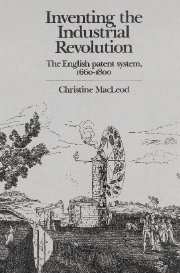Book contents
- Frontmatter
- Contents
- List of tables and figure
- Acknowledgements
- List of abbreviations
- Notes on style
- Introduction
- 1 Patents 1550–1660: law, policy and controversy
- 2 The later-Stuart patent grant – an instrument of policy?
- 3 The development of the patent system, 1660–1800
- 4 The judiciary and the enforcement of patent rights
- 5 The decision to patent
- 6 Invention outside the patent system
- 7 Patents in a capitalist economy
- 8 The long-term rise in patents
- 9 The goals of invention
- 10 Patents: criticisms and alternatives
- 11 A new concept of invention
- Notes
- Bibliography
- Index
11 - A new concept of invention
Published online by Cambridge University Press: 28 October 2009
- Frontmatter
- Contents
- List of tables and figure
- Acknowledgements
- List of abbreviations
- Notes on style
- Introduction
- 1 Patents 1550–1660: law, policy and controversy
- 2 The later-Stuart patent grant – an instrument of policy?
- 3 The development of the patent system, 1660–1800
- 4 The judiciary and the enforcement of patent rights
- 5 The decision to patent
- 6 Invention outside the patent system
- 7 Patents in a capitalist economy
- 8 The long-term rise in patents
- 9 The goals of invention
- 10 Patents: criticisms and alternatives
- 11 A new concept of invention
- Notes
- Bibliography
- Index
Summary
The focus of this final chapter is not the patent system but invention itself and the ways in which it was conceptualized in the seventeenth and eighteenth centuries. This period witnessed not only a gradual reawakening of interest in technology, but also the birth of a new concept of invention. Seventeenth-century discussions of invention were rare and couched largely in metaphysical terms; eighteenth-century ones were comparatively numerous, and their context increasingly economic. Also, while the metaphysical balance shifted from divine to human agency, the economic one moved from the preservation of employment to the benefits of labour-saving inventions.
Lynn Thorndike has remarked on ‘a lack of widespread interest in mechanical invention’ in the seventeenth century, in contrast with the high middle ages and the late eighteenth century and thereafter. This may seem a strange judgement on the century that saw the foundation of the Royal Society in England and of similar societies elsewhere in Europe. But, if one excepts these groups with their passionate interest in all things scientific and technological, then Thorndike's opinion is just. Technical change there was; but manufacturing innovations attracted little notice and scant debate about their role, source, or effect. There persisted a fascination with mechanical wonders, which the seventeenth century had inherited from the middle ages. was evinced by the ‘virtuosi’, those leisured gentlemen who found recreation in ‘learned pleasure and delight’ and collected ‘mechanical toys, wooden birds and iron flies, and parlour tricks’.
- Type
- Chapter
- Information
- Inventing the Industrial RevolutionThe English Patent System, 1660–1800, pp. 201 - 222Publisher: Cambridge University PressPrint publication year: 1988



